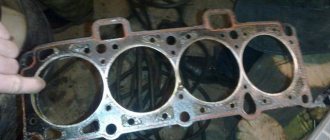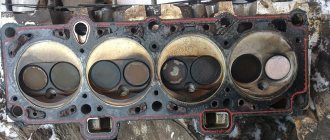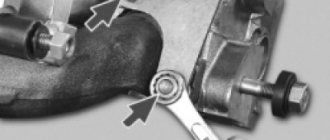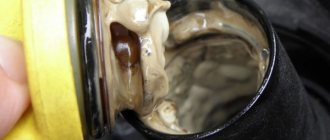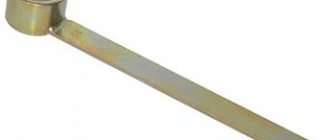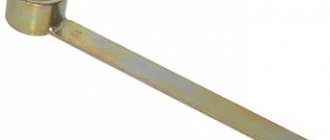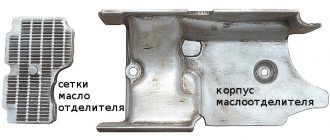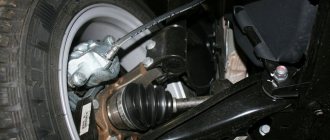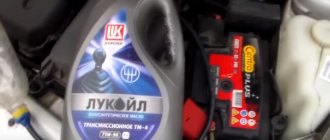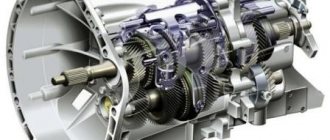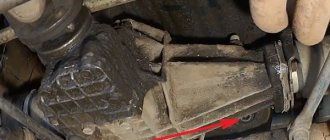An internal combustion engine consists of several parts. One of them is the cylinder head. It is installed on the block itself, which can be cast iron or aluminum. But regardless of the material of manufacture, a gasket is installed between these two components. It prevents gases from escaping into adjacent channels, including the cooling jacket. But sometimes it happens that the cylinder head gasket has blown. This is a serious problem. Why does oil leak from under the cylinder head and how to replace this element? We'll tell you in our article today.
The essence of the breakdown
As we said earlier, there is a sealing element between the head and the block.
It ensures the tightness of the connection between the two components of the engine. It is impossible to visually assess the condition of this gasket. However, its malfunction is fraught with serious consequences. Experts identify the following reasons for replacing the VAZ cylinder head gasket:
- Poorly tightened bolts. This usually occurs due to poor quality repairs.
- Deformation of the gasket itself (unfortunately, no one is immune from defects).
It is not always the gasket that causes an oil leak from under the cylinder head. Reason #2 is engine overheating. As a result, the surface of the cylinder head becomes uneven. Even after replacing the sealing element, oil leakage from under the cylinder head does not stop. It is necessary to grind the cylinder head or replace it with a new one. The latter option is often applied to heads that have cracks. There is no way to repair them. The structure has already lost its strength and tightness.
Causes of damage to the lining
- Gases. Exhaust gases enter the area between the 2nd and 3rd cylinders. The gasket elastomer is deformed in the area of the coolant passage hole. This problem may be caused by the following: loose bolts; dropped cylinder liner; deformed parts; rough surface of spare parts; incorrectly adjusted start of fuel intake.
- The section of the hole for the pusher has delaminated. This may be due to: high loads on the motor; incorrect installation of the sleeve protrusion; uneven surface of the cylinder head.
- Overheating. Thermal overheating of the lining causes the seals to rupture. Overheating can occur due to a low octane index of the fuel, increased compression levels, or incorrectly adjusted spark plugs. Typically, overheating causes the gasket material to swell near the antifreeze passage holes.
- Flow of lubricant over the surface. Typically, pads are used that consist of metal and elastomer. Grooves are formed in the cylinder head, which are sealed with gasket seals. If these grooves are not properly cleaned of dirt or carbon deposits, an oil leak occurs. If installation errors are made, the elastomer layer may become wrinkled. This increases the chance of depressurization.
- Installation errors. Most often, lubricant leaks from under the gasket due to poorly tightened bolts, so it is advisable to repair or change the lining in a specialized car service center whose employees you can rely on.
- Incorrect choice of pad. Often the dimensions of the combustion chamber do not correspond to the size of the lining. An unsuitable gasket, if installed in the motor, will soon be damaged. Also, you should not install products that are manufactured by an unknown company. The oil will continue to leak even after replacement if you use a low-quality lining.
An oil leak is considered a fairly significant problem. Having identified it, you need to immediately take measures to correct it. All procedures are best carried out in car services. This is especially true if you, for example, are a fragile girl in stiletto heels. Do not touch the power unit, much less dismantle it. This can lead to complete breakdown of the vehicle. It will be necessary to carry out major repairs, which are very expensive. It’s easier to immediately pay specialists to fix the oil leak. This way you will spend much less of your own money. The main thing is not to ignore the malfunction. A minor problem can very likely turn into a serious breakdown that makes the vehicle impossible to operate.
A very unpleasant moment, familiar to many motorists, is when oil leaks from under the cylinder head. Many, especially novice car owners, do not pay attention to this, especially if only a couple of drops are leaking. However, if you leave this whole thing to chance, then a harmless “couple” of drops will soon turn into a trickle, and after some time there will be no oil left in the engine at all.
What does this mean?
If the cylinder head gasket has broken, you need to fix this problem urgently. Otherwise, gases may leak into the cooling system. Outwardly, this manifests itself in white smoke from the exhaust pipe. The consistency of the coolant also changes. It will take on the appearance of a carbonated mineral water with many small bubbles. The candles begin to become coated with oil. Misfires appear. The oil level itself drops uncontrollably. If you overlook its level, you may encounter oil starvation. Because of this, the parts of the crank mechanism will work “dry”. The service life of the crankshaft is significantly reduced, and scuff marks appear on the cylinder walls.
In addition, leaked oil begins to attract road dust. It settles on all elements of the power plant. It will be difficult to wash off such plaque even under pressure, using aggressive chemicals.
Debugg
What to do if there is an oil leak from under the cylinder head? There is only one way out of this situation. This is a cylinder head gasket replacement. Its cost may vary. For VAZ cars, a new gasket costs about 400-500 rubles. The price of the product for foreign cars starts from 700 rubles and above, depending on the engine configuration. The cost of the replacement service is about one and a half thousand rubles. The operation requires the dismantling of many hanging elements. But if you wish, you can repeat this procedure yourself. Below we will describe the process of replacing the head gasket.
The cause of the leak is damage to the cylinder head gasket.
If you find that oil is leaking from under the cylinder head, this means that the gasket is damaged. This happens in most cases due to repeated overheating of the engine. Damage to the gasket can result in oil leakage, coolant entering the cylinders or into the oil line, or exhaust gases entering there. Well, the cause of overheating itself can be different - driver inattention, malfunction of any mechanism - for example, a water pump, thermostat, radiator - the presence of leaks. In any case, if the engine overheats, this is a consequence of the driver’s inattention, since this can be prevented.
Very often, after engine repairs, car owners complain that oil or coolant is leaking. However, this does not always mean that the cylinder head or the gasket under it has failed - most of these cases occur due to the fault of unskilled craftsmen who either poorly cleaned the surface of the cylinder block and did not remove the remains of the old stuck gasket, or simply performed the cylinder head repair incorrectly. To eliminate the leak, you can try re-tightening the bolts according to the diagram, and if this does not help, you will have to remove the head again.
But in any case, if oil is leaking from under the cylinder head, you should not close your eyes; this is a cause for serious concern. Therefore, it is best to immediately go to a service station.
You can find out detailed information about prices, as well as sign up for repair work by calling:
An internal combustion engine consists of several parts. One of them is the cylinder head. It is installed on the block itself, which can be cast iron or aluminum. But regardless of the material of manufacture, a gasket is installed between these two components. It prevents gases from escaping into adjacent channels, including the cooling jacket. But sometimes it happens that the cylinder head gasket has blown. This is a serious problem. Why does oil leak from under the cylinder head and how to replace this element? We'll tell you in our article today.
How is the replacement made?
Looking ahead, we note that an important condition during the replacement is the correct tightening of the head bolts. This is the only way to achieve a tight and high-quality surface fit. Otherwise, the integrity of the gasket will be compromised, and the oil will come out again, along with the exhaust gases. The tightening torque for each car is individual and is indicated in the operating instructions.
The work of replacing the gasket is carried out in several stages. First, all attachments are dismantled:
- Ignition coils.
- High voltage wires.
- Air pipes and intake manifold.
- Sensors (throttle position, idle speed, etc.).
- Vacuum booster hose.
Before removing the cylinder head, you need to drain the coolant. Otherwise, when dismantling, you will flood the entire engine with it. If the antifreeze is fresh, it can be reused. The main condition is a clean container for draining and the transparency of the liquid itself. If it has lost its color (remember, it can be red, blue or yellow) or has become cloudy, such a product cannot be reused.
After this, the valve cover is removed. When installing, you must use a new gasket for it. The timing belt is also removed.
Note! The camshaft and crankshaft should not be rotated until the belt has been reinstalled.
How to remove the cylinder head? Keep in mind that the cylinder head bolts may become stuck. To prevent the key from falling off, clean the edges as much as possible from dirt and deposits. Otherwise, you will not be able to unscrew the bolt. Due to the licked edges, it can only be drilled out, which is extremely difficult and dangerous for the engine block.
Next, inspect the head mounting bolts. They should not be elongated. If this is the case (for example, the length of the bolts on Lada Samara engines is no more than 135.5 millimeters), they are replaced with new ones. Before installation, the threads must be treated in oil.
Installation
After removing the old gasket, prepare the surface. How to do it? We clean the surface of the block from dirt (and remnants of the old gasket, if any), and thoroughly degrease it.
The same goes for the area on the head. Both mating surfaces must be extremely dry and clean. Next, the gasket itself is installed. It is important to prevent it from moving relative to the mounting holes. The oil passage hole should be between the third and fourth cylinders. The sealant has already been applied to the surface of the sealing element. There is no need to smear anything additional. Next, the head is put on the engine and tightened with bolts. The camshaft and crankshaft should be at top dead center (when the valves of the first cylinder are fully closed).
Puff
As for tightening, it is done in four stages. Let's look at the technology using the example of the second generation Lada Samara engine. First, the bolts are tightened with a force of 20 Nm. Further, the force increases to 70-85 Nm. At the third stage, the bolts are turned by 90 degrees, at the fourth - by the same amount. After this, the replacement of the gasket can be considered almost complete. Now you know what to do if an oil leak occurs from under the cylinder head.
All that remains is to assemble all the attachments, add antifreeze and perform a test run. During assembly, it is recommended to check the gap between the valves. The bolts are tightened with a torque wrench.
Useful tips and tricks
- It should be remembered that high-quality elimination of oil leaks from under the valve cover requires the correct choice of gasket under the valve cover. To do this, it is optimal to purchase original products or high-quality recommended analogues from well-known manufacturers.
- Before purchasing, the gasket should be carefully inspected, checked for elasticity, and made sure there are no sagging or other defects. The element should not be hard or overdried; even the smallest cracks are not allowed.
- For vehicles that use sealant on the valve cover, only recommended or proven sealant compounds should be used. In this case, it is imperative to strictly follow the application technology.

